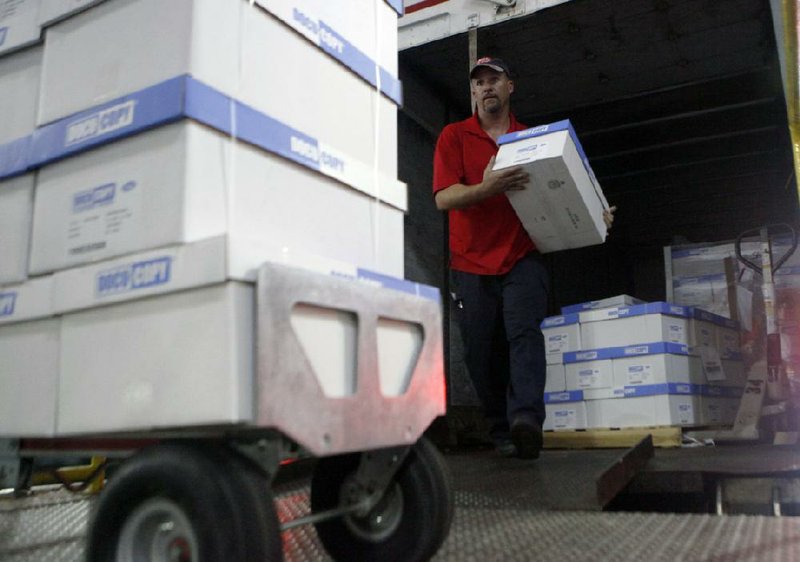WASHINGTON - Hiring is exploding in the one corner of the U.S. economy where few want to be hired: temporary work.
From Wal-Mart to General Motors to PepsiCo, companies are increasingly turning to temps and to a much larger universe of freelancers, contract workers and consultants. Combined, these workers number nearly 17 million people - about 12 percent of everyone with a job.
The rise in temp and contract work suggests many employers aren’t willing to hire for the long run.
The number of temps has jumped more than 50 percent since the recession ended four years ago to nearly 2.7 million - the most on government records dating to 1990. In no other sector has hiring come close.
Driving the trend are lingering uncertainties about the economy and employers’ desires for more flexibility in matching their payrolls to their revenue. Some employers have also sought to sidestep the new health-care law’s rule that they provide medical coverage for permanent workers. Last week, though, President Barack Obama’s administration delayed that provision of the law for a year.
The use of temps has extended into sectors that seldom used them in the past - professional services, for example, which include lawyers, doctors and information technology specialists.
Temps typically receive low pay, few benefits and scant job security. That makes them less likely to spend freely, so temp jobs don’t tend to help drive the economy the way permanent jobs do. More temporary and contract workers also help explain why pay has barely outpaced inflation since the recession ended.
Beyond economic uncertainty, Ethan Harris, global economist at Bank of America Merrill Lynch, said more lasting changes are taking root.
“There’s been a generational shift toward a less-committed relationship between the firm and the worker,” Harris said.
An Associated Press survey of 37 economists in May found that three-quarters thought the increased use of temps and contract workers represented a long-standing trend.
Typical of that trend is Latrese Carr, who was hired by a Wal-Mart in Glenwood, Ill., two months ago on a 90-day contract. She works 10 p.m. to 7 a.m., helping unload trucks and restocking shelves. Her pay is $9.45 an hour. There’s no health insurance or other benefits.
Carr, 20, didn’t particularly want the overnight shift.
“I needed a job,” she said.
The store managers have said some temps will be kept on permanently, Carr said, depending on their performance.
Carr isn’t counting on it.
The trend toward contract workers was intensified by the depth of the recession and the tepid pace of the recovery. A heavy investment in long-term employment isn’t a cost all companies want to bear anymore.
“There’s much more appreciation of the importance of having flexibility in the work force,” said Barry Asin of Staffing Industry Analysts, a consulting firm.
Susan Houseman, an economist at the Upjohn Institute of Employment Research, said companies want to avoid having too many employees during a downturn, just as manufacturers want to avoid having too much inventory if demand slows.
“You have your just-in time work force,” Houseman said. “You only pay them when you need them.”
This marks a shift from what economists used to call “labor hoarding”: Companies typically retained most of their staff throughout recessions, hoping to ride out the downturn.
“We clearly don’t have that anymore,” said Sylvia Allegretto, an economist at the University of California, Berkeley.
The result is that temps and contract workers have become fixtures at large companies. Business executives say they help their companies stay competitive. They also argue that temp work can provide valuable experience.
“It opens more doors for people to enter the labor market,” said Jeff Joerres, chief executive officer of Manpower-Group, a workplace staffing firm.
But Houseman’s research has found that even when jobs are classified as “temp to permanent,” only 27 percent of such assignments lead to permanent positions.
About one-third of temps work in manufacturing. Temps can be found on production lines, repairing machinery and stocking goods in warehouses. About a fifth are administrative.
Shortages of doctors and nurses have led some hospitals to turn to temp agencies. Staffing Industry Analysts forecasts that spending on temporary doctors will grow 10 percent this year and next.
Some school districts now turn to temp firms for substitute teachers. This lets them avoid providing retirement benefits, which union contracts might otherwise require.
Manufacturing unions have pushed back against the trend, with limited success.
“We run into this across all the various industries where we represent people,” said Tony Montana, a spokesman for the United Steelworkers, which represents workers in the steel, paper and energy industries.
Temp hiring has accelerated even though the economy has 2.4 million fewer jobs than it did five years ago. Temp jobs made up about 10 percent of jobs lost to the recession. Yet they’ve made up nearly 20 percent of the jobs gained since the recession ended.
A survey of companies with more than 1,000 employees by Staffing Industry Analysts found they expect 18 percent of their work forces to be made up of temps, freelancers or contract workers this year, up from 16 percent in 2012.
Wal-Mart said it’s been hiring disproportionately more temporary workers.“Flexible associates,” it calls them. Spokesman Dave Tovar said temps allow store managers to provide permanent workers with more reliable schedules.
Online competitors are seeking to upend the temp industry just as Amazon and eBay disrupted retail. Employers spent $1 billion last year hiring workers for short-term projects through online labor exchanges, such as oDesk and Elance, according to Staffing Industry Analysts. That’s 67 percent more than in the previous year.
Freelancers in the online exchanges can be evaluated by employers, post portfolios and take online tests to demonstrate their abilities.
Gary Swart, chief executive of oDesk, said his clients are mainly small or startup companies. But giants like AOL and Unilever are using the service, too.
Business, Pages 23 on 07/09/2013

